Dziga Vertov
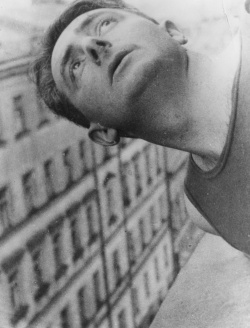 | |
| Born |
January 2, 1896 Białystok, Russian Empire (now Poland) |
|---|---|
| Died |
February 12, 1954 (aged 58) Moscow, Soviet Union (now Russia) |
David Abelevich Kaufman (Давид Абелевич Кауфман; Denis Kaufman; pseudonym Dziga Vertov; Дзига Вертов) was a Soviet pioneer documentary film, newsreel director and cinema theorist. His filming practices and theories influenced the cinéma vérité style of documentary moviemaking and the Dziga Vertov Group, a radical filmmaking cooperative which was active in the 1960s.
Vertov's brothers Boris Kaufman and Mikhail Kaufman were also noted filmmakers, as was his wife, Elizaveta Svilova.
Contents
Filmography
- Kino-nedelya [Кинонеделя; Cinema Week], 43 installments, 1919. [1] [2] [3]. Weekly newsreels. Produced by the Film Committee of the People's Commissariat of Public Education (Moscow). 1 June 1918 through 24 December 1919. Written and directed by Vertov.[1]
- Godovshchina revolyutsii [Годовщина революции; The Anniversary of the Revolution], 12 reels, 1919. [4]. Historical chronicle. Produced by the Film Committee of the People's Commissariat of Public Education (Moscow). Directed by Vertov.[2]
- Boy pod Tsaritsynym [Битва в Царицыне; The Battle of Tsaritsyn], 3 reels, 1919. Produced by the Revolutionary Military Council and the Film Committee of the People's Commissariat of Public Education (Moscow). Written and directed by Vertov.[3]
- Protsess Mironova [Процесс Миронова; The Trial of Mironov; The Mironov Case], 1 reel, 1919. Produced by the Revolutionary Military Council and the Film Committee of the People's Commissariat of Public Education (Moscow). Written and directed by Vertov.[4]
- Vskrytie moshchey Sergiya Radonezhskogo [The Disinterment of Serge Radoneski], 2 reels, 1921. Film-reportage. Produced by the Film Committee of the People's Commissariat of Public Education (Moscow). Written and directed by Vertov.[5]
- Agitpoezd VTsIK [Агитпоезд ВТсИК; The Propaganda Train of the Russian Central Executive Committee], 1 reel, 1921. Travelogue. Produced by the Russian Central Executive Committee and the Film Committee of the People's Commissariat of Public Education (Moscow). Written and directed by Vertov.[6]
- Istoriya grazhdanskoy voyny [История гражданской войны; A History of the Civil War], 13 reels, 1922. Historical chronicle. Produced by the Photo-Film Division (Moscow). Written and directed by Vertov.[7]
- Protsess eserov [Процесс эсеров; The Trial of the Socialist Revolutionaries; Trial of the Socialist-Revolutionary Party], 3 reels, 1922. Produced by the Photo-Film Division (Moscow). Written and directed by Vertov.[8]
- Kinokalendar (State Film-Calendar), 55 issues, 1923-25. Daily and weekly (flash) newsreels. Produced by Goskino (Kultkino). 21 July 1923 through 5 May 1925. Written and directed by Vertov. Includes "Lenin Film-Calendar".[9]
- Kino-Pravda [Кино-Правда], 23 issues (30-37, 40, 43), 1922-25. [5] [6] [7] [8] [9] [10] [11] [12] [13]. Film-newspaper. Produced by Goskino (Moscow). 5 June 1922 through 1925. Shooting plan, intertitles, and direction by Vertov. All installments of the Kino-pravda appeared under this title, with the exception of the eight issues: Yesterday, Today, Tomorrow (13), 1923; Autumn Pravda (16), 1923; Black Sea--Sea of Ice--Moscow (19), 1924; Pioneers' Pravda (20), 1925; Leninist Kinopravda (21), 1924; Lenin Lives in the Peasant's Heart (22), 1925; Radio-Kinopravda (23), 1925; Give Us Air (Special issue), 1924.[10]
- Sovietskie igrushki [Советские игрушки; Soviet Toys], 1924.
- Kino-Glaz: zhizn' vrasplokh [Кино-глаз: Жизнь врасплох; Kino-Eye: Life Unrehearsed], first series, 6 reels, 1924. [14] [15]. Produced by Goskino (Moscow). Written and directed by Vertov. Cameraman: Mikhail Kaufman.[11]
- Shagay, sovet! [Шагай, Совет!; Forward, Soviet! (The Moscow Soviet: Past, Present, and Future], 6 reels, 1926. [16] [17] Newsreels. Produced by Goskino (Kultkino) (Moscow). Written and directed by Vertov. Cameraman: I. Belyakov. Film scout: Kopalin. Assistant to the director: Elizaveta Svilova.[12]
- Shestaya chast mira [Шестая часть мира; A Sixth of the World (Gostorg's Import-Export. Kino-Eye's Travels through the USSR], 6 reels, 1926. [18] [19] [20] [21]. Film-poem. Produced by Goskino (Kultkino) and Sovkino (Moscow). Written and directed by Vertov. Assistant director and chief cameraman: Mikhail Kaufman. Cameramen: I. Belyakov, S. Benderski, P. Sotov, N. Constantinov, A. Lemberg, N. Strukov, I. Tolchan. Film scouts: A. Kagarlitski, I. Kopalin, B. Kudinov.[13]
- Odinnadtsatyi [Одиннадцатый; The Eleventh Year], 6 reels, 1928. [22] [23]. Newsreels. Produced by the Ukrainian Film and Photography Administration (VUFKU) (Kiev). Written and directed by Vertov. Cameraman: Mikhail Kaufman. Assistant to the director: Elizaveta Svilova.[14]
- Chelovek s kino-apparatom [Человек с киноаппаратом; Man with a Movie Camera], 6 reels, 1929. [24] [25] [26]. Film-feuilleton. Produced by the Ukrainian Film and Photography Administration (VUFKU) (Kiev). Written and directed by Vertov. Chief cameraman: Mikhail Kaufman. Assistant to the director: Elizaveta Svilova.[15]
- Entuziazm: Simfoniya Donbassa [Энтузиазм: Симфония Донбаса; Enthusiasm], 6 reels, 1930. [27] [28] [29] [30]. Documentary sound film. Produced by Ukrainfilm. Written and directed by Vertov. Cameraman: B. Zeitlin. Sound engineer: P. Shtro. Assistant to the director: Elizaveta Svilova.[16]
- Tri pesni o Lenine [Три песни о Ленине; Three Songs About Lenin], 6 reels, 1934. [31] [32] [33]. Documentary sound film. Produced by Mezhrabpomfilm. Written and directed by Vertov. Cameramen: D. Sourenski, M. Magidson, B. Monastyrsky. Sound engineer: P. Shtro. Score by I. Shaporin. Assistant to the director: Elizaveta Svilova.[17]
- Kolybelnaya [Колыбельная; Lullaby], 7 reels, 1937. [34] [35]. Documentary sound film. Produced by Soiuzkinokhronika. Written and directed by Vertov. Co-director: Elizaveta Svilova. Soiuzkinokhronika cameramen. Score by D. and D. Pokrass. Sound engineer: I. Renkov. Lyrics by V. Lebedev-Kumach.[18]
- Pamyati Sergo Ordzhonikidze [Памяти Серго Орджоникидзе; In Memory of Sergo Ordzhonikidze], 2 reels, 1937. [36]. Special issue. Produced by Soiuzkinokhronika. Editor: Vertov. Co-director: Elizaveta Svilova.[19]
- Sergo Ordzhonikidze [Серго Орджоникидзе; Sergo Ordzhonikidze], 5 reels, 1937. Documentary sound film. Produced by Soiuzkinokhronika. Directed by Vertov, I. Bliokh, E. Svilova, V. Dobronitsky, Soloviev, Abjibeliachvili. Score by I. Dunayevsky. Sound engineers: I. Renkov, S. Semenov. Musical arrangements by D. Blok. Lyrics by Lebedev-Kumach.[20]
- Hail the Soviet Heroines!, 1 reel, 1938. Special issue. Produced by Soiuzkinokhronika. Written and directed by Vertov. Co-director: Elizaveta Svilova. Soiuzkinokhronika cameramen.[21]
- Tri geroini [Три героини; Three Heroines], 7 reels, 1938. Documentary sound film. Produced by Soiuzkinokhronika. Script by Vertov and Elizaveta Svilova. Directed by Vertov. Chief-cameraman: S. Semenov, with staff of Moscow, Khabarovsk and Novosibirsk newsreel studios. Train views: M. Troyanovsky. Score by D. and D. Pokrass. Sound engineers: A. Kampovski, Fomine, Korotkevitch. Lyrics by Lebedev-Kumach. Assistant to the director: S. Semov.[22]
- V rayone vysoty A [In the High Zone], 1941. Film-reportage shot on the front of the Great Patriotic War (Film-Newspaper no. 87). Produced by the Central Newsreel Studio. Directed by Vertov. Cameramen: T. Bunimovitch, P. Kassatkin.[23]
- Krov za krov, smert za smert [Кровь за кровь, смерть за смерть; Blood for Blood, Death for Death (The Misdeeds of the Fascist Invaders in the USSR)], 1 reel, 1941. Produced by the Central Newsreel Sutdio. Filmed by cameramen serving at the front. Directed by Vertov.[24]
- На линии огня - операторы кинохроники [Newsreel Cameraman in the Line of Fire], 1941. Film-reportages shot on the fronts of the Great Patriotic War. (Film-Newspaper no. 77). Written and directed by Vertov. Co-director: Elizaveta Svilova. Aerial sequences by N. Vikhirev.[25]
- Kazakhstan - frontu! [Казахстан — фронту!; To You, Front! (Kazakhstan for the Front)], 5 reels, 1942. [37]. Documentary sound film. Produced by the Alma-Ata Film Studio. Written and directed by Vertov. Co-director: Elizaveta Svilova. Chief cameraman: B. Pumpiansky. Score by G. Popov, V. Velikanov. Sound engineer: K. Bakk. Lyrics by V. Lougovskoy.[26]
- V gorakh Ala-Tau [В горах Ала-Тау; In the Mountains of Ala-Tau], 2 reels, 1944. Documentary sound film. Produced by the Alma-Ata Film Studio. Written and directed by Vertov. Cameraman: B. Pumpiansky. Co-director: Elizaveta Svilova.[27]
- Klyatva molodykh [Клятва молодых; The Oath of Youth], 3 reels, 1944. Produced by the Central Documentary Film Studio. Directed by Vertov, Elizaveta Svilova. Cameramen: I. Belyakov, G. Amirov, B. Borkovsky, B. Dementiev, S. Semenov, V. Kossitsyn, E. Stankevitch.[28]
- Novosti dnya [Новости дня; Daily News], 1944-54. Film-newspaper. Produced by the Central Documentary Film Studio. Vertov's involvement was occasional. 1944: no. 18; 1945: nos. 4, 8, 12, 15, 20; 1946: nos. 2, 8, 18, 24, 34, 52, 67, 71; 1947: nos. 6, 13, 21, 30, 37, 48, 51, 65, 71; 1948: nos. 8, 19, 23, 29, 34, 39, 44, 50; 1949: nos. 19, 27, 43, 45, 51, 55; 1950: nos. 7, 58; 1951: nos. 15, 33, 43, 54; 1952: nos. 9, 15, 31, 43, 54; 1953: nos. 18, 27, 35, 55; 1954: nos. 31, 46, 60.[29]
- DVDs
- Man with the Movie Camera, DVD, Film Preservation Associates, 1998; 2002. Score by The Alloy Orchestra. Audio commentary track by Yuri Tsivian. [38]
- The Cinematic Orchestra, Man With A Movie Camera, DVD, Ninja Tune, 2003. [39] [40]
- Man With a Movie Camera, DVD, 2005, Madman Films. With Three Songs of Lenin. Score by Michael Nyman. [41] [42]
- Entuziazm (Simfonija Donbassa), 2-disc DVD, Edition Filmmuseum 01, 2005; 2nd ed., 2006; 3rd ed., 2007. Restored version and unrestored version plus documentary on Peter Kubelka's restoration (65 min). [43] [44]
- Sestaja cast' mira & Odinnadcatyj, 2-disc DVD, Edition Filmmuseum 53, 2009; 2nd ed., 2010. Both films with score by Michael Nyman. [45] [46]
- Landmarks of Early Soviet Film: A 4-Disc DVD Collection of 8 Groundbreaking Films: 1924-1930, with Vertov's Forward, Soviet!, Flicker Alley, 2011. [47] [48]
Literature
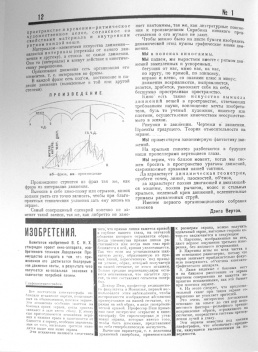
Second page of Vertov's "My. Variant manifesta" (1922) with a diagram illustrating his concept of the interval.
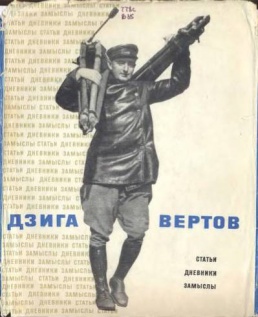
Dziga Vertov, Statii, dnevniki, zamysly, 1966. (in Russian) Download.
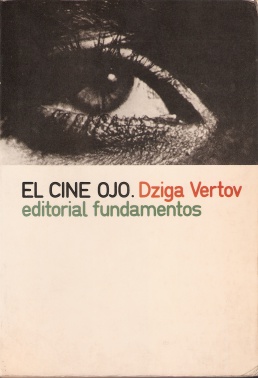
Dziga Vertov, El cine-ojo, 1973. (in Spanish) Download.
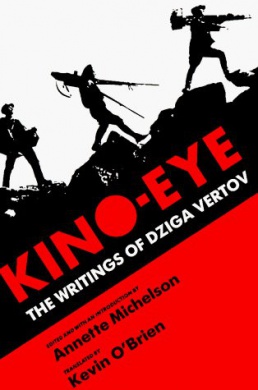
Kino-Eye: The Writings of Dziga Vertov, 1984. Download.
Selected Articles and Talks by Vertov
- "My. Variant manifesta" [Мы, Вариант манифеста], Kino-fot [Кино-Фот] 1 (25 August 1922), pp 11-12; reprinted in Statii, dnevniki, zamysly, ed. Sergei Drobashenko, Moscow: Izd. Iskusstva, 1966, pp 45-49. (in Russian) [49] [50]. The first appearance in print of the program of the kinok-documentalist group formed by Vertov in 1919. As Vertov testifies, the original conception for the manifesto goes back to 1919. In the article "From Kino-Eye to Radio-Eye" he writes: "Moscow. The end of 1919. An unheated room. A small vent-window with a broken pane. Next to the window a table. On the table, a glass of yesterday's undrunk tea that has turned to ice. Near the glass is a manuscript. We read: 'Manifesto on the Disarmament of Theatrical Cinematography.' One of the variants of this manifesto, entitled 'WE', was later (1922) published in the magazine Kinofot (Moscow)."[30] The article includes two illustrations: one of a "bespredmetnaja grafika" [abstract drawing] by Aleksandr Rodchenko, dating from 1915, the second is the diagram intended to illustrate Vertov's concept of the interval.
- "Wir. Variante eines Manifestes", in Aufsätze, Tagebücher, Skizzen, 1967, pp 55-57; repr. in Texte zur Theorie des Films, ed. Franz-Josef Albersmeier, Reclam, 1998, pp 31-35. (in German)
- "Nosotros: Variante del manifiesto", in El cine-ojo, trans. Francisco Llinas, Madrid: Editorial Fundamentos, 1973, pp 15-19. (in Spanish)
- "We: A Version of a Manifesto", in Kino-Eye: The Writings of Dziga Vertov, ed. Annette Michelson, trans. Kevin O’Brien, University of California Press, 1984, pp 5-9.
- "NoS: Variante de manifesto". (in Portuguese)
- "Kinoki. Perevorot", LEF 3 (1923), pp 135-143; reprinted in Statii, dnevniki, zamysly, ed. Sergei Drobashenko, Moscow: Izd. Iskusstva, 1966, pp 50-58. (in Russian). Portions of a projected book by Vertov. The article is one of the more important theoretical statements made by the director during the mid-1920s. While in part developing the theses of the manifesto "WE", it sums up the creative experience that Vertov received while working on the magazines Kinonedelia [Film-week] and Kinopravda [Film-truth] and on his first short films, The Anniversary of the Revolution, The Battle of Tsaritsyn, and The Trial of Mironov. Vertov also summarizes his theoretical observations from those years on the specific nature of cinema.[31]
- "Kinoks - Revolucion", in El cine-ojo, trans. Francisco Llinas, Madrid: Editorial Fundamentos, 1973, pp 20-31. (in Spanish)
- "Kinoks: A Revolution", in Kino-Eye: The Writings of Dziga Vertov, ed. Annette Michelson, trans. Kevin O’Brien, University of California Press, 1984, pp 11-21.
- "Kinoki – Umsturz", in Texte zur Theorie des Films, ed. Franz-Josef Albersmeier, Reclam, 1998, pp 36-50. (in German)
- "O znacenii neigrovoj kinematografii", 1923; first printed in Statii, dnevniki, zamysly, ed. Sergei Drobashenko, Moscow: Izd. Iskusstva, 1966, pp 69-72. (in Russian). An abridged shorthand report of a talk by Vertov at a public debate held at ARRK [Association of Workers in Revolutionary Cinematography] on 26 September 1926.[32]
- "La importancia del cine no interpretado", in El cine-ojo, trans. Francisco Llinas, Madrid: Editorial Fundamentos, 1973, pp 45-49. (in Spanish)
- "On the Significance of Nonacted Cinema", in Kino-Eye: The Writings of Dziga Vertov, ed. Annette Michelson, trans. Kevin O'Brien, University of California Press, University of California Press, 1984, pp 35-38.
- "Pozhdenie Kinoglaza", dated 1924; first printed in Statii, dnevniki, zamysly, ed. Sergei Drobashenko, Moscow: Izd. Iskusstva, 1966, pp 73-75. (in Russian). Theses for an article.[33]
- "Nacimiento del cine-ojo", in El cine-ojo, trans. Francisco Llinas, Madrid: Editorial Fundamentos, 1973, pp 51-53. (in Spanish)
- "The Birth of Kino-Eye", in Kino-Eye: The Writings of Dziga Vertov, ed. Annette Michelson, trans. Kevin O’Brien, University of California Press, 1984, pp 40-42.
- "O Kinoglaze", 1924; first printed in Statii, dnevniki, zamysly, ed. Sergei Drobashenko, Moscow: Izd. Iskusstva, 1966, pp 75-79. (in Russian). An abridged shorthand report of a speech by Vertov at a conference of the kinoks on 9 June 1924. The speech clearly characterizes Vertov's attitude toward so-called intermediate trends in cinematography (according to the kinoks, the films of Eisenstein were included in this category). Calling works of this type "acted films in newsreel trousers", "surrogates", etc., Vertov saw in them a danger for the Soviet documentary. New material pertaining to the history of the film journal Kinopravda is also contained in this speech.[34]
- "El Kinopravda", in El cine-ojo, trans. Francisco Llinas, Madrid: Editorial Fundamentos, 1973, pp 53-59. (in Spanish)
- "On Kinopravda", in Kino-Eye: The Writings of Dziga Vertov, ed. Annette Michelson, trans. Kevin O'Brien, University of California Press, 1984, pp 42-47.
- "Kinoglaz", in Na putiakh iskusstva: Sbornik statei [On the Paths of Art], Moscow: Proletkult, 1926; repr. in Statii, dnevniki, zamysly, ed. Sergei Drobashenko, Moscow: Izd. Iskusstva, 1966, pp 89-104. (in Russian). Slightly abridged.[35]
- "Cine-ojo", in El cine-ojo, trans. Francisco Llinas, Madrid: Editorial Fundamentos, 1973, pp 71-89. (in Spanish)
- "Kino-Eye", in Kino-Eye: The Writings of Dziga Vertov, ed. Annette Michelson, trans. Kevin O’Brien, University of California Press, 1984, pp 60-79.
- "Kinoglaz", in Aufsätze, Tagebücher, Skizzen, 1967; repr. in Texte zur Theorie des Films, ed. Franz-Josef Albersmeier, Reclam, 1998, pp 51-53. (in German)
- "Chelovek s kino-apparatom", dated 1928; first printed in Statii, dnevniki, zamysly, ed. Sergei Drobashenko, Moscow: Izd. Iskusstva, 1966, pp 106-109. (in Russian). Theses for an article.[36]
- "El hombre de la camara", in El cine-ojo, trans. Francisco Llinas, Madrid: Editorial Fundamentos, 1973, pp 92-94. (in Spanish)
- "The Man with the Movie Camera", in Kino-Eye: The Writings of Dziga Vertov, ed. Annette Michelson, trans. Kevin O'Brien, University of California Press, 1984, pp 82-85.
Vertov's Collected Writings
- Vertov, Dziga (1966). Drobashenko, Sergei. ed. Statii, dnevniki, zamysly [Статьи. Дневники. Замыслы]. Moscow: Izd. Iskusstva. pp. 320 (Russian).
- Aufsätze, Tagebücher, Skizzen, Institut für Filmwissenschaft an der Deutschen Hochschule für Filmkunst, 1967, 375 pp. (in German)
- Articles, journaux, projets, trans. Sylviane Mossé and Andrée Robel, Paris: Union générale d'éditions, 1972, 442 pp. (in French)
- El cine-ojo, trans. Francisco Llinas, Madrid: Editorial Fundamentos, 1973, 215 pp. (in Spanish)
- Vertov, Dziga (1984). Michelson, Annette. ed. Kino-Eye: The Writings of Dziga Vertov. trans. Kevin O’Brien. University of California Press. pp. 408.
- Schriften zum Film, Hanser, 1976, 170 pp. (in German)
- Tagebücher, Arbeitshefte, eds. Thomas Tode and Alexandra Gramatke, UVK: Konstanz, 2000, 276 pp. (in German) Foreword, [51]
- Iz nasledia 1 [Из наследия. Том 1. Драматургические опыты], eds. Aleksander Deriabin (Александр Дерябин) and D.V. Kruzhkova (Д. В. Кружкова), Eisenstein Centre, 2004, 536 pp. (in Russian)
- Iz nasledia 2 [Из наследия. Том 2. Статьи и выступления], eds. Aleksander Deriabin (Александр Дерябин) and D.V. Kruzhkova (Д. В. Кружкова), Eisenstein Centre, 2004, 648 pp. (in Russian)
- Memorias de un cineasta bolchevique, trans. Joaquín Jordà, Madrid: Capitán Swing Libros, 2009. (in Spanish)
- L'occhio della rivoluzione. Scritti dal 1922 al 1942, ed. P. Montani, Mimesis, 2011, 276 pp. (in Italian)
Books on Vertov
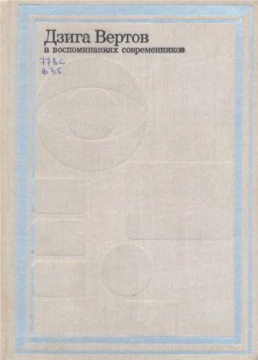
Elizabeta Vertova-Svilova, Anna L. Vinogradova (eds.), Dziga Vertov v vospominanijach sovremennikov, 1976. (in Russian) Download.
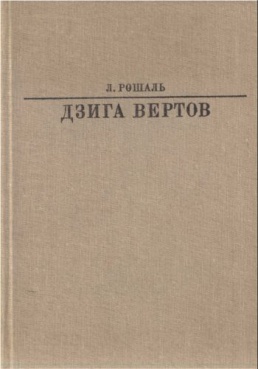
Lev Roshal, Dziga Vertov, 1982. (in Russian) View online.
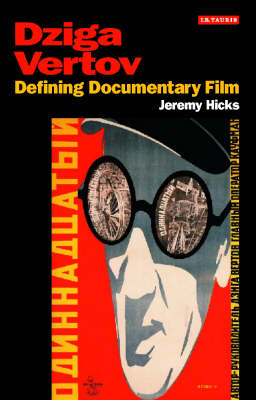
Jeremy Hicks, Dziga Vertov: Defining Documentary Film, 2007. Download.
- Nikolai Abramov (Николай Абрамов), Dziga Vertov [Джига Вертов], Moscow: Izd. Akademii Nauk, 1962, 165 pp. (in Russian)
- Dziga Vertov, trans. Barthelemy Amengual, Lyon: Serdoc, 1965. (in French)
- Georges Sadoul, Dziga Vertov, Paris: Champ libre, 1971, 171 pp. Preface by Jean Rouch. (in French)
- El cine de Dziga Vertov, Era, 1973, 223 pp. (in Spanish)
- Antonín Navrátil, Dziga Vertov. Revolucionář dokumentárního filmu, Prague: Čs. filmový ústav, 1974. (in Czech)
- Elizabeta Ignatyevna Vertova-Svilova (Елизавета Игнатьевна Вертова-Свилова), Anna L. Vinogradova (Анна Львовна Виноградова) (eds.), Dziga Vertov v vospominanijach sovremennikov [Дзига Вертов в воспоминаниях современников], Moscow: Iskusstvo, 1976, 280 pp. (in Russian)
- Seth Feldman, Evolution of Style in the Early Work of Dziga Vertov, New York: Arno Press, 1977.
- Seth Feldman, Dziga Vertov, A Guide to References and Resources, Boston: G.K.Hall, 1979, 232 pp.
- Vasco Granja, Dziga Vertov, Livros Horizonte, 1981, 96 pp. (in Portuguese) Part.
- Lev Roshal (Лев Моисеевич Рошаль), Dziga Vertov [Дзига Вертов], Moscow, 1982, 263 pp. (in Russian)
- Frédérique Devaux, L'Homme à la caméra de Dziga Vertov, Brussels: Yellow Now, 1990, 126 pp. (in French)
- Vlada Petrić, Constructivism in Film: The Man with the Movie Camera: a Cinematic Analysis, CUP Archive, 1993, 325 pp; 2nd Edition, 2012. [52]
- Jean-Pierre Esquenazi (ed.), Vertov. L'invention du réel!, Paris: L'Harmattan, 1997, 286 pp. (in French)
- Natascha Drubek-Meyer, Jurij Murasov (eds.), Apparatur und Rhapsodie: zu den Filmen des Dziga Vertov, Frankfurt: Peter Lang, 2000, 283 pp. (in German) [53]
- Graham Roberts, The Man with the Movie Camera, I. B. Tauris, 2001.
- Yuri Tsivian (ed.), Lines of Resistance: Dziga Vertov and the Twenties, trans. Julian Graffy, Gemona: Le Giornate del Cinema Muto, 2004, 422 pp. [54]
- Excerpt: "Celluloid Manifesto: Reading images and emblems in Dziga Vertov's films", 12 April 2011.
- Thomas Tode, Barbara Wurm (eds.), Dziga Vertov. The Vertov Collection at the Austrian Film Museum / Dziga Vertov. Die Vertov-Sammlung im Österreichischen Filmmuseum, Vienna: Austrian Film Museum, 2006, 288 pp. (in German/English). Contents, [55].
- Klemens Gruber (ed.), Verschiedenes über denselben: Dziga Vertov 1896-1954, Vienna/Cologne/Weimar: Böhlau, 2006, 125 pp. (in German). Contents
- Jeremy Hicks, Dziga Vertov: Defining Documentary Film, London & New York: I. B. Tauris, 2007.
- Peggy Ahwesh, Keith Sanborn (eds.), Vertov from Z to A, trans. Keith Sanborn, New York: Ediciones la Calavera, 2008, 169 pp.
- David Tomas, Vertov, Snow, Farocki: Machine Vision and the Posthuman, Bloomsbury Academic, 2013, 304 pp.
- Dziga Vertov, Life and Work, Indiana University Press. (forthcoming) [56] [57]
Journal Issues devoted to Vertov
- Maske und Kothurn 42:1 (1996), Special Issue: "Dziga Vertov zum 100. Geburtstag", ed. Klemens Gruber, Vienna: Böhlau 1996. Proceedings from the Vertov-Symposium Wien 1996. (in German)
- Maske und Kothurn 50:1 (2004), Special Issue: "Der kreiselnde Kurbler. Dziga Vertov zum 100. Geburtstag Bd. 2: Vorträge und Gespräche des Vertov-Symposiums in Wien", eds. Klemens Gruber and Aki Beckmann, Vienna: Böhlau 1996. (in German)
- October 121 (Summer 2007), Special Issue: New Vertov Studies, eds. Annette Michelson and Malcolm Turvey. Contents.
- Maske und Kothurn 55:3 (2009), Special Issue: "Digital Formalism. Die kalkulierten Bilder des Dziga Vertov", eds. Klemens Gruber and Barbara Wurm with Vera Kropf, Vienna: Böhlau, 230 pp. (in German) [58]
Book chapters, Papers and Articles on Vertov
- Erik Barnouw, Documentary: a History of the Non-fiction Film, Oxford University Press, 1974.
- Malcolm Le Grice, Abstract Film and Beyond, MIT Press, 1977.
- Vlada Petric, "Dziga Vertov as Theorist", Cinema Journal 18:1 (Autumn 1978), pp 29-44.
- Anna Lawton, "Rhythmic Montage in the Films of Dziga Vertov: A Poetic Use of the Language of Cinema", Pacific Coast Philology, Vol. 13 (October 1978), pp 44-50.
- Peter Weibel, "Eisenstein, Vertov and the Formal Film", trans. Phillip Drummond, in Film as Film: Formal Experiment in Film, 1910-1975, London: The Arts Council of Great Britain, 1979, pp 46-51.
- Gilles Deleuze, "Towards a gaseous perception", in Cinema 1: The Movement-Image, trans. Hugh Tomlinson and Barbara Habberjam, University of Minnesota Press, 1986, pp 80-86, n229-230.
- Ben Singer. "Connoisseurs of Chaos: Whitman, Vertov and the 'Poetic Survey'", Literature/Film Quarterly 15:4 (Fall 1987), pp 247-258.
- Vlada Petric, "The Vertov Dilemma: Film-Eye vs Film-Truth", Spectator 12:1 (Fall 1991), pp 6-17. [59]
- Patricia R. Zimmermann, "Reconstructing Vertov: Soviet Film Theory and American Radical Documentary", Journal of Film and Video 44:1-2 (Spring-Summer 1992).
- William C. Wees, "The Camera-Eye: Dialectics of a Metaphor", in Light Moving in Time: Studies in the Visual Aesthetics of Avant-Garde Film, University of California Press, 1992, pp 11-30. [60]
- Philip Vilas Bohlman, Music, Modernity, and the Foreign in the New Germany, 1994, pp 121-152.
- Vlada Petric, "Vertov's Cinematic Transposition of Reality", in Beyond Document: Essays on Nonfiction Film, ed. Charles Warren, Wesleyan University Press, 1996, pp 271-294.
- Seth Feldman. "'Peace between Man and Machine': Dziga Vertov's The Man with a Movie Camera.", in Documenting the Documentary: Close Readings of Documentary Film and Video, eds. Barry Keith Grant and Jeannette Sloniowski, Wayne State University Press, 1998, pp 40-53.
- Jonathan L. Beller, "Dziga Vertov and the Film of Money", Boundary 2 26:3 (1999), pp 151-199
- Malcolm Turvey, "Can the Camera See? Mimesis in Man With a Movie Camera", October 89 (Summer 1999).
- Douglas Kahn, "Russian Revolutionary Film", in Noise, Water, Meat: A History of Sound in the Arts, MIT Press, 1999, pp 139-156.
- Lev Manovich, "Prologue: Vertov's Dataset", in The Language of New Media, MIT Press, 2001, pp xiv-xxxvi.
- Mariano Prunes, "Dziga Vertov's Three Songs about Lenin (1934): A Visual Tour through the History of the Soviet Avant-Garde in the Interwar Years", Criticism 45:2 (Spring 2003)
- Klemens Gruber, "Das überrumpelte Leben. Dziga Vertov als Choreograph", in Versehen. Tanz in allen Medien, eds. Helmut Ploebst and Nicole Haitzinger, Munich: epodium, and Vienna: corpus, 2011, pp 34-51. (in German)
- Jane de Almeida (ed.), Grupo Dziga Vertov, Sao Paulo: Witz, 2005. (in Portuguese)
- MacKay, John (January 2005). "Disorganized Noise: Enthusiasm and the Ear of the Collective". KinoKultura (7): 51.
- John MacKay, "The 'Spinning Top' Takes Another Turn: Vertov Today", KinoKultura 8 (April 2005).
- John MacKay, "Allegory and Accommodation: Vertov's Three Songs of Lenin (1934) as a Stalinist Film", Film History: An International Journal 18:4 (2006), pp 376-391. [61]
- Malcolm Turvey, "The Revelationist Tradition: Exegesis: II", in Doubting Vision Film and the Revelationist Tradition, Oxford University Press, 2008, pp 31-37.
- Irina Sandomirskaia, "One Sixth of the World: Avant-garde Film, the Revolution of Vision, and the Colonization of the USSR Periphery during the 1920s (Towards a Postcolonial Deconstruction of the Soviet Hegemony)", in From Orientalism to Postcoloniality, ed. Kerstin Olofsson, Huddinge: Södertörns högskola, 2008, pp 8-31.
- John MacKay, "Stride Soviet (1926) and Vertovian Technophobia", 2008.
- Jean-Luc Godard y el Grupo Dziga Vertov, 1968-1974, Barcelona: Prodimag, 2008, 61 pp. Booklet for videodiscs set. (in Spanish) [62]
- Yates McKee, "Post-Communist Notes on Some Vertov Stills", in Communities of Sense: Rethinking Aesthetics and Politics, eds. Beth Hinderliter, et al., Durham & London: Duke University Press, 2009, pp 267-293.
- John MacKay, "Dziga Vertov: 1896-1954", 2009. A short biography of Vertov.
- Sergio Delgado, "Dziga Vertov’s Man with a Movie Camera and the Phenomenology of Perception", Film Criticism 34:1 (2009), pp 1-16.
- Kirill Medvedev (Кирилл Медведев), Kirill Adibekov (Кирилл Адибеков), борьба на два фронта. жан-люк годар и группа дзига вертов, 1968-1972, свободное марксистское издательство, 2010. (in Russian)
- John MacKay, "A Revolution in Film", Artforum (April 2011), pp 196-203, n238.
- Christian Quendle, "Rethinking the camera eye: dispositif and subjectivity", New Review of Film and Television Studies 9:4 (December 2011), pp 395-414.
- John MacKay, "Dziga Vertov (1896-1954)", in Russia's People of Empire, eds. Stephen M. Norris and Willard Sunderland, Indiana University Press, 2012, pp 282-294. [63]
- John MacKay, "Vertov and the Line: Art, Socialization, Collaboration", in Film, Art, New Media: Museum Without Walls?", ed. Angela Dalle Vacche, Palgrave Macmillan, 2012, pp 81-96.
- Joshua Malitsky, "The Dialectics of Thought and Vision in the Films of Dziga Vertov, 1922-1927", in Post-Revolution Nonfiction Film: Building the Soviet and Cuban Nations, Indiana University Press, 2013. [64]
- Smirnov, Andrey (2013a). "The Laboratory of Hearing". Sound in Z: Experiments in Sound and Electronic Music in Early 20th-century Russia. London: Koenig Books & Sound and Music. pp. 25-28.
- Smirnov, Andrey (2013b). "Dziga Vertov - Enthusiasm: Symphony of the Donbass". Sound in Z: Experiments in Sound and Electronic Music in Early 20th-century Russia. London: Koenig Books & Sound and Music. pp. 166-167.
- John MacKay, "Built on a Lie: Propaganda, Pedagogy, and the Origins of the Kuleshov Effect", in The Oxford Handbook of Propaganda Studies, 2013, pp 215-232.
- John MacKay, "Kinoglaz (Vertov, 1924)", in Il cinema russo attraverso i film, eds. Alessia Cervini and Alessio Scarlato, Rome: Carocci, 2013. (in Italian). Translated from English.
- John MacKay, "The subjective camera in Vertov's Lullaby (1937)", 2013. Talk.
- John MacKay, "Man with a Movie Camera: An Introduction", 2013.
- Lev Manovich, "Visualizing Vertov", 2013, 38 pp.
- Articles on Vertov at Seance.ru. (in Russian)
Documentary Films about Vertov
- Мир без игры, dir. Sergei Drobashenko, 54 min, 1966. [65]
- Дзига и его братья, dir. Evgeny Tsymbal, 2002.
- Все Вертовы, dir. Vladimir Nepevny, 2002.
Notes
- ↑ Michelson 1984, p. 330
- ↑ Michelson 1984, p. 330
- ↑ Michelson 1984, p. 330
- ↑ Michelson 1984, p. 330
- ↑ Michelson 1984, p. 330
- ↑ Michelson 1984, pp. 330-331
- ↑ Michelson 1984, p. 331
- ↑ Michelson 1984, p. 331
- ↑ Michelson 1984, p. 331
- ↑ Michelson 1984, pp. 331-332
- ↑ Michelson 1984, p. 332
- ↑ Michelson 1984, p. 332
- ↑ Michelson 1984, p. 332
- ↑ Michelson 1984, p. 332
- ↑ Michelson 1984, p. 332
- ↑ Michelson 1984, p. 332
- ↑ Michelson 1984, p. 333
- ↑ Michelson 1984, p. 333
- ↑ Michelson 1984, p. 333
- ↑ Michelson 1984, p. 333
- ↑ Michelson 1984, p. 333
- ↑ Michelson 1984, p. 333
- ↑ Michelson 1984, p. 333
- ↑ Michelson 1984, pp. 333-334
- ↑ Michelson 1984, p. 334
- ↑ Michelson 1984, p. 334
- ↑ Michelson 1984, p. 334
- ↑ Michelson 1984, p. 334
- ↑ Michelson 1984, p. 334
- ↑ Vertov 1984, p. 321
- ↑ Vertov 1984, p. 321
- ↑ Vertov 1984, p. 322
- ↑ Vertov 1984, p. 323
- ↑ Vertov 1984, p. 323
- ↑ Vertov 1984, p. 324
- ↑ Vertov 1984, p. 324
See also
External links
- Dziga Vertov in UbuWeb Sound: Enthusiasm! (1930), Laboratory Of Hearing (1916), Radio-Ear / Radio-Pravda (1916).
- Vertov at Sense of Cinema
- Dziga Vertov Collection at the Austrian Film Museum
- Vertov.ru
- Vertov at IMDB
- A short biography of Vertov by John MacKay
- Dziga Vertov and Early Animation: Sarah Lewis Interviews Professor John MacKay, 2010.
- Man With a Movie Camera: The Global Remake